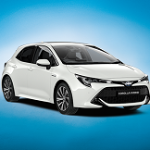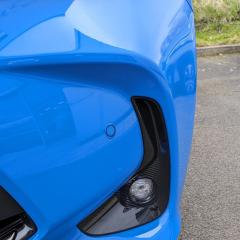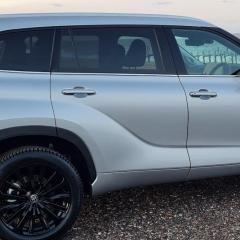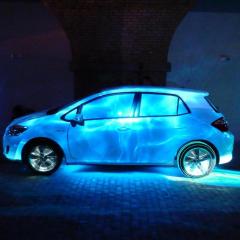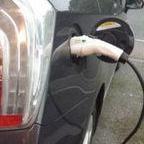Leaderboard
Popular Content
Showing content with the highest reputation on 02/21/2020 in all areas
-
2 points
-
I am blaming ALDI for all these stolen Catalytic converters. In their store today are hydraulic car trolley jacks for £19.99. Cheap as chips, no wonder thefts are increasing, almost tempted to get one and a grinder and set up in business.2 points
-
I'm not a fan of the Ioniq. Visually, I think it looks like a cheap knockoff of a Prius, although to my eyes the facelift Gen4 is such a step backwards that it actually manages to look like a cheap Prius knockoff itself, so no loss there. However, this is the real problem... Ugh. The Toyota e-CVT is perfectly matched to hybrid driving. Who'd want the perpetual lurch and thump of gearchanges in a car that is resolutely not built for 'spirited' driving, when they could enjoy super smooth seamless progress instead? I'm pretty sure Hyundai only fitted the dual-clutch to appease idiot motoring journalists who were always whining on about the Toyota 'CVT' because they thrash the sorry ***** off everything they drive and didn't like it mooing away at them. Intentional or not, the strategy worked, because the Ioniq routinely fares better with the mainstream motoring press than the Prius and, perhaps as a result, has sold well too. I was going to take one for a test drive, just to see how bad it was, before buying the PHV. However, after sitting in it for 5 minutes I didn't even bother. The interior was so utterly drab and boring, and the seats so unnecessarily rock hard, I couldn't bring myself to waste the salesman's time. As a side note, the plug-in Ioniq inexplicably has the charging point on the nearside front wing, making it completely impossible to access in a tight garage. I totally get wanting a change, but I'm with Tony on the Toyota/Lexus hybrid superiority thing and wouldn't look elsewhere for a hybrid. If I was looking at a Hyundai, it would be a Kona electric, which appears to be a genuinely interesting and original car. Still, we're all different. I hope you enjoy whatever you end up with. 🙂2 points
-
We take delivery of a Prius PHV (2018 model) on Thursday. I have been reading about the Charge Mode where you can divert some energy from the ICE in HV mode to refill the EV battery. My research found a pair of Youtube videos, in German but with data sheets at end, showing comparable runs in both HV and HV/Charge Mode. The results show that at motorway speeds (German 130 Km p h /82 mph) you can refill the EV battery at about 1 mile EV for every 1.5 miles travelled. The fuel penalty seems to be easily offset by using the generated EV miles once off the motorway in town conditions. (My calculation in UK terms seems to move fuel from about 9p/mile (55mpg) to under 8p/mile.) I appreciate that charging from the mains is a lot cheaper but it does seem worthwhile to use his feature if your journey includes a lot of town driving at the end (or of course changing to EV for your last 20 miles or so of motorway driving) Does anybody have experience of this mode? Cheers Toshtosh1 point
-
1 point
-
I thought you already had, what with your username! An insider to pass on Hybrid locations from users profiles! James.1 point
-
I'd get your sales person to put the "free" upgrade in writing as Toyota have stated the update will be £50 in conjunction with a service and £150 at any other point.1 point
-
(joke alert [emoji6]) Sent from my Pixel 3 XL using Tapatalk1 point
-
More on various experiences of Charge mode here:1 point
-
I think a lot of journalists just don't like them because they're different - the car doesn't make the right vroom-vroom noises that they expect and they seem unable to look beyond that. One thing about the Ioniq is that they must be doing something right, because fuel efficiency is still very good and comparable to the Prius. I'd be interested to see how they drive, but they're very rare around here. The large majority of Ioniqs sold in Ireland are the full BEV versions (which are also comparatively very efficient versus competitors). The hybrid/PHEV Kona and Kia Niro are more popular and probably have similar powertrains, but I haven't got to check them out either (I have no interest in crossovers).1 point
-
Yes, the current PHV has a "charge mode", but it's not really an efficient driving solution.1 point
-
The fourth Generation Prius was, in most respects, the best car I've ever had, but with a couple of caveats: The roof starts sloping downwards from above the drivers's head, and it's the first Prius version with compromised rear headroom - it's ok for some, but I found it hard to get in the back, and I couldn't sit upright because the roof was too low. But the killer for me was the low floor and seating. It was really comfortable while seated in the front, but getting it and out caused such massive problems with my hips, which spread to my knees and back, I just had to get rid of it. I was very sad to see it go, and I wish there was some way I could have kept it. I quite like my RAV4 Hybrid, but I like it an awful loss less than the Prius, except that my pain had completely vanished by the time I'd had it 4 months. I even started investigating having the Prius fitted with air suspension so I could raise it for getting in and out, but it quickly became apparent that would have been way to problematic, not least because I'd have lost the spare wheel well and some of the boot. Plus I didn't relish trying to persuade my insurer the modification wasn't about getting extreme handling capability! I ruled out most other manufacturers' Hybrids because I also wanted the planetary drive train of the Toyota/Lexus system, and not a dual clutch system or some of the other Hybrid variations used. In fairness, I must say a friends Skoda with the DSG gearbox is remarkably smooth for that type of transmission, but I still would find it annoying after some 330,000 miles in Toyota/Lexus Hybrids. Some reviewers in the USA think the latest incarnation of the Honda Hybrid system is now better than Toyota's system, but it's only available on the C-RV SUV in the UK - in the US there's the Insight, a Prius lookalike that now has the new system too. As far as I can ascertain, the electric motor does almost all the driving at most speeds, and when extra power is need the engine starts but powers generator to give a boost to the electric motors. At higher speeds, when needed, the engine can be connected to the drive train via a clutch with a single speed gear, but only at higher speeds. It means the Honda system can now do all the tricks of electric only, electric plus engine and engine only, but achieved in a very different way to the Toyota system. Before this, all Honda Hybrids had either a manual gearbox and clutch (like the first Insight), or a 'proper CVT gearbox (containing cones and belts) mated to a torque converter. I would have chosen the Honda C-RV Hybrid if it had a spare wheel, but it didn't. Also, the Hyundai looks like it has even worse rear headroom than the 4th Gen Prius, so if that matters it would be worth checking it out before considering one.1 point
-
Go along with what been said about the Prius drivetrain, you know very well, driverDave, how relaxing it is to drive the Prius with its drivetrain. Apart from an expensive clutch to replace in the future, do you really want to be "paddling" gears instead of having a true "auto"box. Apart from anything else, Dave, the Prius Gen4 in Hypersonic Red looks absolutely fantastic ( I got one as well)1 point
-
I personally would not get another hybrid different from Toyota - Lexus , exactly for the same reason, the power train. This is the only drive train of all makes that gets closest to driving a full ev and reliable as one. If I want a clutch auto box will get a dsg on golf R to GTI. Just personal preference. Otherwise Hyundai and kia are good cars.1 point
-
I've had, since 2002, RAV4, Corolla, Prius 2, Prius 3, RAV4, RAV4 Hy, Prius Plug. In the 90's I also went through 3 Diahatsu ( same marque now ). I've had Land Rover, Datsun (!), Hillman, Fiat (yeuch!) and Rover. None have compared to the reliability of Toyota, though Toyota have had some niggles and questionable interiors/switch positions to their cars :D. If only they'd hurry up and sort out an EV that's worth looking at. Mind it'd have to be good to surpass the usefulness of the plug-in ( even in HV mode with a heavy battery! ). We're likely coming up for a change this Summer....1 point
-
Hi 2Sav, Cracking thread! I too am the proud owner of a Carina II (a '91 XL Windsor Liftback in my case) - I'm based in Lancaster so you may even have seen it about on your travels. Here's a picture of it at the 2019 Festival of the Unexceptional (spotted 3 or 4 other Carina IIs whilst I was there - must be some sort of record!). Here's another besides a very rare contemporary stable mate spotted outside a screwfix in Coventry: It was my first car and the only car I have owned to date - I bought it for £700 in the Summer of 2010 with 37k on the clock and it was a total minter. Garaged all it's life, consecutive MOTs with only 30 miles covered between them it belonged to a clearly fastidious elderly owner who lived just down the road from my parents and sadly passed away. In ten years and ~50,000 miles it has never ever let me down and the only work it's ever needed bar an annual service is a new clutch slave cylinder (car was still driveable, but with about 0.1 mm between clutch fully in and out!) and a new rad last year. It's still a great runner and regularly makes the trip from Lancaster down to the midlands sitting quite happily at an indicated 90ish for a couple of hours 😁. It just needs some TLC to make it mint again - I'm assembling parts to get some work done this summer, main jobs to be done are: - Replace spring & dampers all round (lowering spring or standard ride height...?) - Repair/replace rear bumper (Twisted by an unfortunate impact with a bollard outside the Warwick University Physics department circa 2012...) - Replace oil cooler hard lines (look absolutely buggered but don't seem to be leaking) Budget permitting: - Upgrade to 15" wheels so I can find some better tyres (Still had the original Dunlop SP7s on it when I bought it - drove beautifully on them, ancient Cooper Sportmaster GLEs don't quite compare) - Find someone reputable to fabricate a new SS exhaust from the manifold back and replace manifold heat shield (stilll available from Toyota :)). These really are cracking motors - must be the high water mark in terms of engineering quality and durability, not that the modern stuff is bad by any means. Speak to any Taxi driver that was working in the early/mid 90s and they'll tell you legendary stories of Carina IIs with 2 billion miles on the clock that served as taxis for 3 generations of the same family! Seem to have a big following in Ireland and decent ones easily go for £1000+ these days - not bad to get more back in your pocket than you originally laid out after ten years of trouble free motoring! Try doing that with a new Audi.... Right I did come on here to ask you a question - I see you had the suspension replaced on your car shortly after buying it - can I ask what parts you used? I was thinking of going with KYB as they seem to be the choice for OEM replacement Jap stuff...I believe Toyota also possibly own part of the company but that may be BS. Cheers, Matt PS Annoyingly some of the pictures from your earlier posts have been blurred out - don't suppose there's anyway you can restore them? This is quite a useful resource for anyone else with a Carina II!1 point
-
The Honest John website, which entered administration last month, has been bought by Heycar. Heycar is a used car marketplace owned by Volkswagen Financial Services and Daimler Mobility, which has recently entered the UK market. Be interesting to see how impartial the HJ website remains in the future.1 point
-
Unclip the lid to the washer reservoir, put your finger over the pinhole and lift off the cap. You will be able to see the fluid level by the amount left in the tube. Now you have the bonnet open, you can check the oil level, coolant and brake levels too. Simples!1 point
-
I queried the price with Toyo Tech, as to it being a fixed price of £250. They have come back and apologized say they based it on the invoice, which when they looked was for 2 items and not one. So it will be less than the price of Toyota's price. Thanks for the heads up, as I would not have known. And no, my one is still there hopefully till they fit the cat lock.1 point
-
The Scrap Metal Dealers Act 2013 already requires dealers to be licenced, for them to record details of the sale and seller, and not to pay cash for scrap metals. This doesn't prevent thieves from illegally exporting stolen cats to circumnavigate the law.1 point
-
1 point
-
In the interests of dodgy science, I've done some more playing with Charge mode as well. 1. It appears to be a terrible idea to do the 'fifty-fifty' approach of charge/EV mode on normal journeys away from motorways/dual carriageways, if you are seeking to maximise economy. That makes sense, because by doing so you will actually reduce the time spent in EV mode. I routinely see well above 60% of the journey with the engine off when in HV mode, so forcing the engine to run for 50% of the time is bound to have a negative effect. On my commute of 32 miles, it seems to trash economy by 10-15mpg. 2. It is a far less terrible idea to do 'fifty-fifty' on the motorway, which is the approach Tony has posted about. A brief experiment on a mainly dual carriageway journey netted me 85mpg on the way out using HV mode and 81mpg on the way back doing a 'half and half' with charge mode. That's not a saving, but it's close enough with all the other variables involved, and far closer than what I managed on my commute. It should also be noted I am sad enough to have spent years learning how to maximise HV mode economy in a range of hybrids. For someone who is less interested in all that nonsense and just wants to drive, I could well imagine switching between Charge mode and EV mode would yield better results to the point of it being more economical.1 point
-
1 point
-
Does the old fashioned charge method work on the new PHEV? With the car in ready, put into Drive with foot on the brake pedal. Keeping foot on brake pedal, press the accelerator. The ICE should now charge the HV battery.1 point
-
Quick short experiment, Leverburgh to Stornoway is around 55 miles. The road traverses a section of high ground especially north of Tarbet with a few long stretches of both ascents and declines. On the decline section I used charge mode and went from zero to 15 miles, and still achieved 89.8 mpg for the complete journey [All HV mode]. ( It was too dull to stop for any of the usual photographic opportunities. )1 point
-
To be honest I drive at about the speed limit in most conditions. I will do a few more checks and post some correctly recorded data. Cheers Tony B1 point
-
Hold down the HV button for 3 seconds or so, and charge mode will be engaged. What speeds are you doing? I'm guessing pretty fast if you're using 8 litres of petrol to go 110 miles in HV mode!1 point
-
Right. I'm over in Uist at the moment. EV charge now depleted after 12 days of driving just on HV, first in Lewis/Harris. The CYC app doesn't work and an RFD card didn't arrive in time for me to use the (mostly) free charge points. I've browsed the manual for the charge mode, and can't find the damn thing! It's not desperate, most of the journeys have yielded into the 80's, way better than the RAV4 hybrid we had last year, and better than the gen2&3 before it. It would be useful to have some charge to save gassing the poor ferry crew more than they all ready are!1 point
-
After several long distance runs my results, although not controlled, suggest that the use of charge mode does give a minor saving over using the HV mode, but it is marginal. However you do get to run almost half those miles in EV, which is, in my opinion, much better than HV driving. In charge mode it uses about 3.5 litres (per 30 miles) to give 25 miles of EV. In HV mode a run of 110 miles would need about 8 litres of petrol. So on a run of 110 miles in HV charge mode you would run about 30 miles (3.5 litres) in charge mode then 25 miles or so in EV, repeated for the final 55 miles. So the potential saving by toggling HV charge mode and EV is about 1p per mile or £1 per 100 miles. OOI we did a 230 mile journey this weekend at over 199 mpg by using three public chargers to top up - all linked in to stops for shopping or refreshment. (Beverley - free, Driffield - free and Lidl in York - £1.20). Although not the fastest charge rate The PHV gives about 30 miles range after 2 hours. A couple of overnight charges on the domestic supply.1 point
-
Understand your points and will test Normal HV out next time we do a long run. I am certain the miles we did on Charge Mode used more fuel than HV only, but to match the 50 miles or so we got from Charge Mode it would need to be less than 6 litres for the 100 miles or so we travelled in total for 5.8 litres. Can you achieve 90mpg in HV mode? Cheers Tony B1 point
-
Indeed! I'm always surprised (don't know why) that when the EV battery runs out, the car can still travel a fair distance on EV under HV mode. On other journeys from home, on a 100% battery, I can still regenerate and add a further mile to the 100%. It remains a great drive, improving on the Gen2 & 3 and RAV4 Hy. But damn it's hard to remember how limited that boot space is - especially after the Rav!1 point
-
Interesting. The acid test would be to repeat the journey in normal mode. If your 4 plug in charges give you about 130 miles, the remaining 90 miles might use less than 5.8 litres in normal mode, but you'll have to try it and see. My post above didn't intend to detract from the fun of playing with the car's toys- I went through that phase when mine was new, but I drive in lots of traffic and don't have a regular commute to get bored with. I just wanted to say that there's a different kind of driving pleasure in keeping everything simple and relaxed, and the fuel consumption when doing so will be a pleasant surprise.1 point
-
Our first run in the Prius has been completed and with judicious charging and using the charge mode we completed a 220 mile journey with 5.8 litres of petrol (full to full). That is well over 150 mpg plus 3 full paid charges (about £3) and one free top up in the Flemingate shopping centre. About 75% was EV so we travelled about 55 miles on charge mode. This is about 45mpg. The charge mode seems to generate 1EV mile for every mile travelled so we recovered about 50 EV miles on the journey, so I assume that would be the same as 90mpg in normal HV mode. Whichever way you look at it the Prius PHV is amazing at 4p per mile. None of this was at the cost of slow driving - mainly A roads at speed limits. More results in the future. Tony B1 point
-
Up to a point, that is sound advice but where's the fun in that? Surely half the enjoyment of driving a Prius is endlessly obsessing over the information screens and trying to find new techniques to maximise miles per gallon? 😄 My commute would be boring as hell if I wasn't trying to work out some daft new scheme to maximise economy, like trying to decide whether switching to EV mode to go up hills is more economical than using the ICE, or determining precisely how cold I'm prepared to let my feet get before switching on the heater, or whether it's more economical to overtake the tractor in electric-only EV City rather than letting the ICE take some of the strain in standard EV mode... Sometimes those daft ideas actually work, too. The car is very clever at managing itself to maximise efficiency, but it can still be beaten. For example, if I switch to HV mode on the way to work after 20 miles, saving what's left in EV for the journey home, that gets me consistently better average mileage than when I leave the car to itself and it exhausts the EV range on the first leg. Would it be even better if I switched after 15 miles, and saved even more for the return? Maybe. That might just be next week's challenge... Come on. Don't deny me the thrill of discovery by suggesting I'd be better off just letting the car do its thing. It's the only thrill I get these days!1 point
-
Charge mode is entirely for future legislation in this country, or present legislation in other countries, which forbids exhaust emissions in certain city areas- you use it to charge up before you enter. It will always have a detrimental effect on overall fuel consumption- sending power from petrol engine to wheels is more efficient than sending it from petrol engine, to generator to inverter to battery from battery to inverter to motor to wheels. New Prius owners always want to understand how it works and drive to beat the Toyota default. After about three months it dawns on you- you can't. Just go to the dashboard settings, switch off every bit of dashboard display you can, then sit back, relax, and concentrate on the steering wheel, accelerator and brake (and that little lever that tells it whether to go forwards or backwards is sometimes useful too). Doing this, I guarantee you'll get better consumption than by any special driving technique or trick use of the car's various modes. Enjoy your new car Pete1 point
-
It's not just regen in HV mode. As Aaron said above, the car will divert any 'spare' ICE energy into the battery whenever it works out that it's not needed to drive the wheels. It's not unusual to see the EV range creep up when accelerating gently in HV. Of course, you'll never 'fill up' in HV mode but I've seen it pick up a couple of miles of EV range over 30 miles of driving. I've experimented with Charge mode and found it had a negative impact on economy, although I wasn't on a motorway to be fair. I'll keep using HV mode myself, but I'll be interested to hear how you get on with it. Please let us know! Averaging 100mpg across 10k miles shouldn't be a problem in that scenario, although how far you can go above that will depend on weather throughout the year as that has a dramatic impact on EV range. On a warm, dry day I'll get 32-36 actual miles on EV. On a cold, wet day that will drop all the way down to 16-20 miles. On a journey of 80 miles, that will have an enormous impact on mpg - expect less than 100mpg in the winter months, balanced by considerably more in the summer.1 point
-
In HV mode it will still use MG1 to charge the battery in order to maintain the state of charge to an extent, not just regen. "HV Auto" mode will make more use of the battery until it is depleted to HV-only levels. There are no separate "parts" of the battery as such, there are just two modes of how the car displays the SOC - the "EV" showing around 30-80% SOC, and the "HV" showing around 20-30% SOC (equivalent of a standard Prius). It only displays the latter once the battery is near the lower range of SOC. For longer journeys, assuming you're starting with a full charge, it'll more efficient to use HV mode and switch to EV for low-speed sections. It's even recommended in the manual in my Gen 1 Plug-in (probably same for the Gen 2). Charge Mode does not seem like an efficient solution to me. I think the intention is for using before entering strict LEV/ZEV zones if such things exist somewhere (or maybe they will in future), and you didn't have an opportunity to charge off the mains.1 point
-
Thanks for Thanks for the info I have no intention of not using mains charge wherever possible or using HV where I have EV capacity. However I understand that in HV mode the Prius only uses regenerative battery charging to maintain the HV part of the battery, whereas in the charge mode it diverts some of the ICE power into topping up the EV part of the battery. It seems that if all it has to do is spin a generator then the conversion should be reasonably efficient and for under an extra litre or so of fuel you could get about 20 miles of EV. I look forward to using the fully charged EV (from home/public charging) for most of our use, and 100 mpg as an average seems easy on a 10k annual mileage with most days being sub 80 miles. OOI I have a Skoda Octavia 1 litre turbo that is averaging 49mpg so there was a high bar for the new car. Cheers Tony B1 point
-
I think a little of the extra advantage plug-in Prius seem to have over the ordinaire variety is that when you charge the battery it also fills the bit of the HV range that would be almost always empty in the standard car. When I switch mine off at the end of the day, I may have anything from 2 to 7 bars on the HV battery gauge, dependent on whether I approached on the dual carriageway from the south, in which case I'll have been braking from 60 mph down a gentle incline to the last roundabout before entering my village (7 bars) or come in on the coast road at 20-40 mph largely in EV (car's choice) (probably ending up on 2-4 bars). The plugin is like me being able to charge the missing bit somehow and that will explain a small part of the plugin's advantage. A former member of this group (who's now bought a EV and disappeared) previously had a first gen plugin, and he suggested another part of the advantage was the fact plugins used Lithium Ion technology instead of the Prius ordinaire's NiMH, and he believed the former's charge/discharge efficiency was greater.1 point
-
I would be disinclined to trust your YouTube sources, on the basis that if they're driving at 82mph and trying to be economical (either financially or in terms of fuel), then they're doing it wrong! There's a lot of inefficiency in Charge mode - you're using an inefficient source (the ICE) to put power into the battery with associated transfer losses, then you're getting that power back out of the battery with further associated losses. Whilst not all the power harvesting will be inefficient (the hybrid system is fiendishly clever in siphoning off power that isn't 'needed') the car is set up to do that all the time anyway even when not in Charge mode. In the circumstances you describe, I would suggest that it would be more efficient to charge the car at home and just switch to HV mode during the journey once the EV range drops to approximately the amount of 'town driving' you're going to do at the end of your journey. That will keep enough in the battery to use EV mode in town, without wasting fuel in Charge mode. This is basically what Geoff is describing above, using HV as the default. That only makes sense on long journeys though - don't switch to HV mode and then find you get back home to your charger with EV range to spare! The only time I could see Charge mode having any real value is if you can't charge the car from a socket before setting off. It could then be used on a long run to build up charge for EV driving later on. Even then, the transfer losses mean that I'm not convinced it would work out more to be more efficient overall, but it would give the advantage of reducing local noise and pollution in the built-up area. Personally I'd just stick with HV mode which gives pretty phenomenal returns even on an empty battery. It is at least as good as the Gen4 ordinaire despite the extra weight being lugged around, possibly because it can store more regen charge in the larger battery. Set the cruise to 65mph on the motorway, leave the outside lane to the German dieselburgers, relax and enjoy an easy 70+mpg. Away from the motorway, I'v found mid-90s mpg to be achievable on a warm day when starting with zero EV range, although perhaps not in Yorkshire as you have proper hills up there!1 point
-
No problem Tony. Mind that 80's was in winter, on winter tyres - so I'm expecting a little bit more when winter finishes. I'm tempted more by HV as default, retaining EV for city/town driving. But it's all swings and roundabouts.1 point
-
Fully understand the standard HV mode and thanks for the guidance on MPG in the Prius PHV. I was expecting nearer 60mpg at motorway speed and less in towns. I will update on Charge Mode costs/savings once I've done my own test - as a Yorkshireman every penny saved...... Also every mile on EV saves a drop of pollution (If it is more efficient to use the petrol for charge mode than moving the car by ICE of course). Cheers Tony B1 point
-
Hi Anthony. I've never used that option. I didn't think it worth the excessive use of petrol just to gain a few more miles on the battery. If I have no battery charge to draw on, in EV, I still find the HV mode gives MPG into the 80's - what's not to like! ( Don't forget HV still has an EV element to draw on - just like the standard Toyota hybrids ).1 point


